 |
 |
 |
| |
Racial Differences in Long-Term Changes in Metabolic and Body Composition Parameters in Antiretroviral Naive Persons Initiating HAART:
Results of the CPCRA 061 Metabolic Study
|
| |
| |
Reported by Jules Levin
9th Intl Workshop on Adverse Drug Reactions and Lipodystrophy in HIV
July 19-21, 2007, Sydney, Australia
Cynthia L. Gibert, Judith C. Shlay, Shweta Sharma,
Glenn Bartsch, Grace Peng, Carl Grunfeld
for the CPCRA and INSIGHT Groups
AUTHOR'S SUMMARY/CONCLUSIONS - Metabolic
In this non-randomized long-term evaluation, metabolic parameters showed increases after initiation of ART
- glucose and insulin increased later than lipids
- there was a long-term decrease in LDL.
Latinos had the greatest increases in triglycerides, LDL, glucose and insulin resistance.
African-Americans had the smallest increases in triglycerides and LDL.
SUMMARY/CONCLUSIONS - Body Composition
For all racial groups an early and beneficial impact of ART on body composition was observed.
There was an increase in thigh and mid-arm (not shown) non subcutaneous tissue area as well waist visceral tissue area for all races.
--Smallest increase in African-Americans for mid-arm and waist non subcutaneous tissue area.
Over time, decreases were seen mid-thigh subcutaneous tissue area (fat), but little difference by race.
Over time Latinos had the greatest loss in waist and mid-arm subcutaneous tissue areas (fat).
CONCLUSIONS
With the greatest increase in HIV infection in the US now occurring in African-Americans and Latinos, it is important to understand the racial differences in both metabolic parameters and body composition parameters.
These racial differences confirm the need for specific monitoring of lipids, glucose and body composition changes.
These racial differences may be considered in choice of ART.
BACKGROUND
Changes in metabolic and body composition parameters are well-described consequences of antiretroviral therapy.
Limited data are available on the racial differences in the long-term changes of these parameters following the initiation of ART in ART-naive patients.
OBJECTIVE
To assess long-term changes in metabolic and body composition parameters by race among African-American, Latino and white ART-naive patients.
The drop-out rate increased at 4 years so results after the 4-year timepoint loses reliability although followup in this study goes to 5 years.
FIRST STUDY
Patients randomized to PI+NRTIs or NNRTI+NRTIs, or PI + NNRTI regimen. 422 patients are in Metabolic Substudy; Whites n=112; African-Americans=243, latinos n=43, total N=398. Patients were excluded with diabetes or hyperlipidemia at baseline. Remember, patients switched therapies from the regimen they were randomized too during the course of the study. So they may have started on PI or NNRTI but switched.
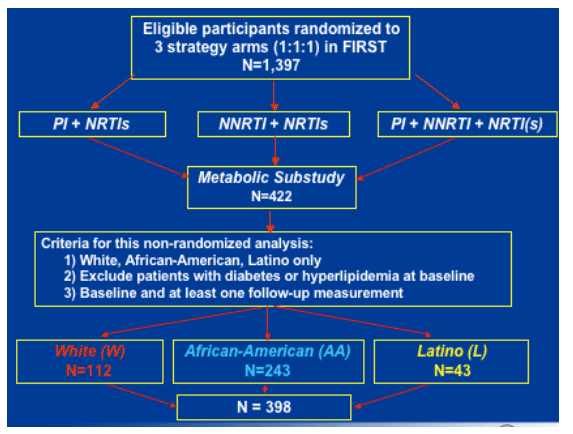
METHODS
Metabolic and body composition measurements taken at baseline, month 1 (metabolic only), and every 4 months
Metabolic for 62 mos.; Body Comp for 48 mos.
Mean change from baseline compared across the 3 race groups
Repeated measures regressions used to compute rates of change (slopes) over time by race group (per month); p < 0.05 deemed significant
For pairwise comparisons, p < 0.017 significant (Bonferroni adjustment)
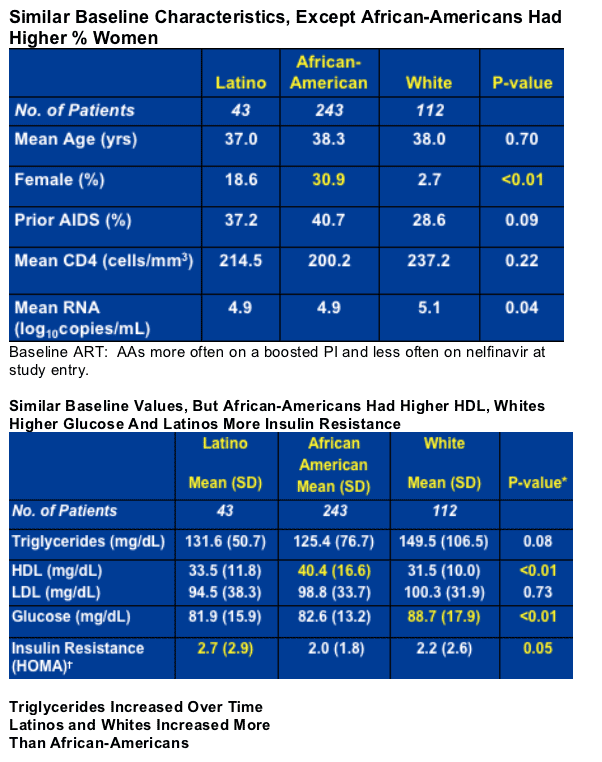

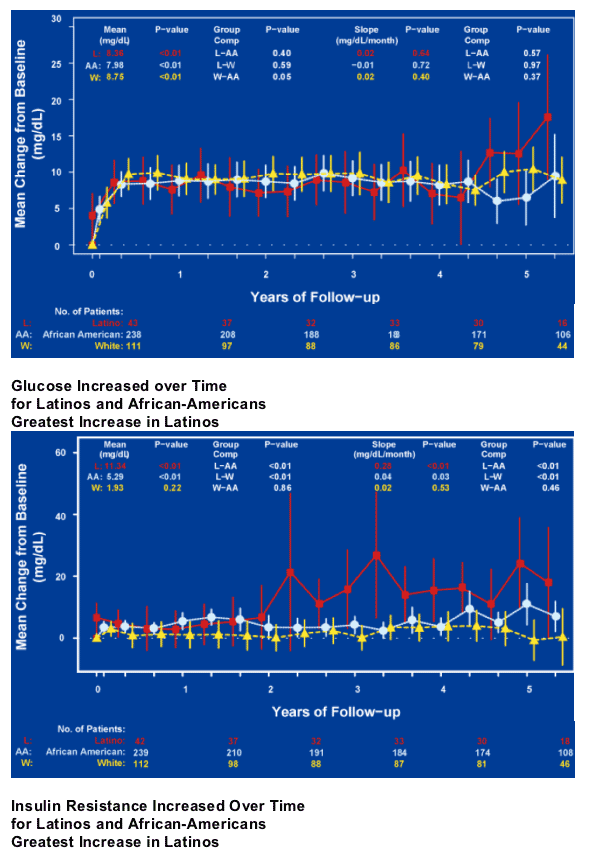
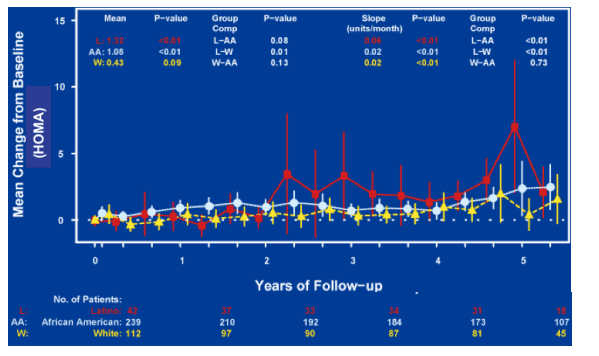
Body Composition Measures
The various tissue components calculated from the following:
--Body circumferences: mid-arm, waist and mid-thigh
--Skinfolds: triceps, abdomen, and thigh

THE NUMBERS OF PATIENTS IN THE ANALYSES FALL OFF AFTER 4 YEARS so Grunfeld said to discount the results after 4 years.
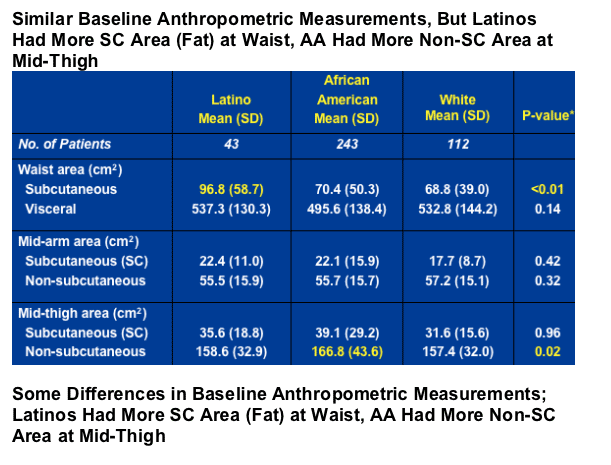

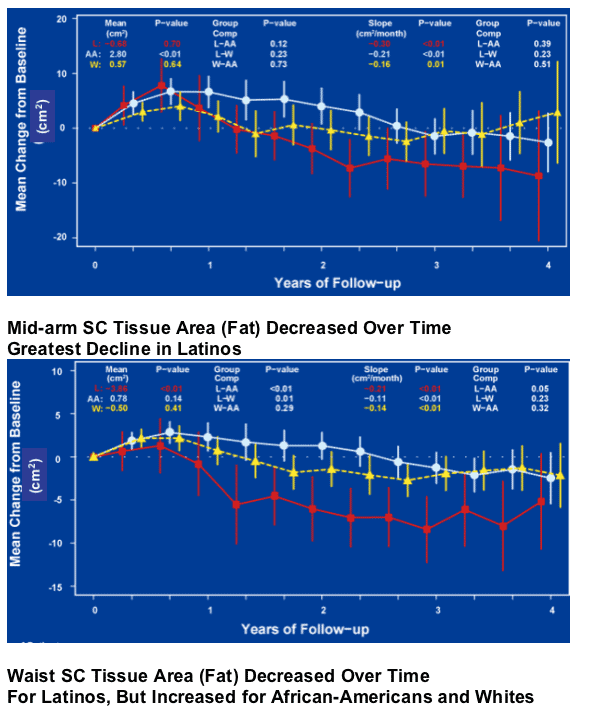

|
| |
|
 |
 |
|
|